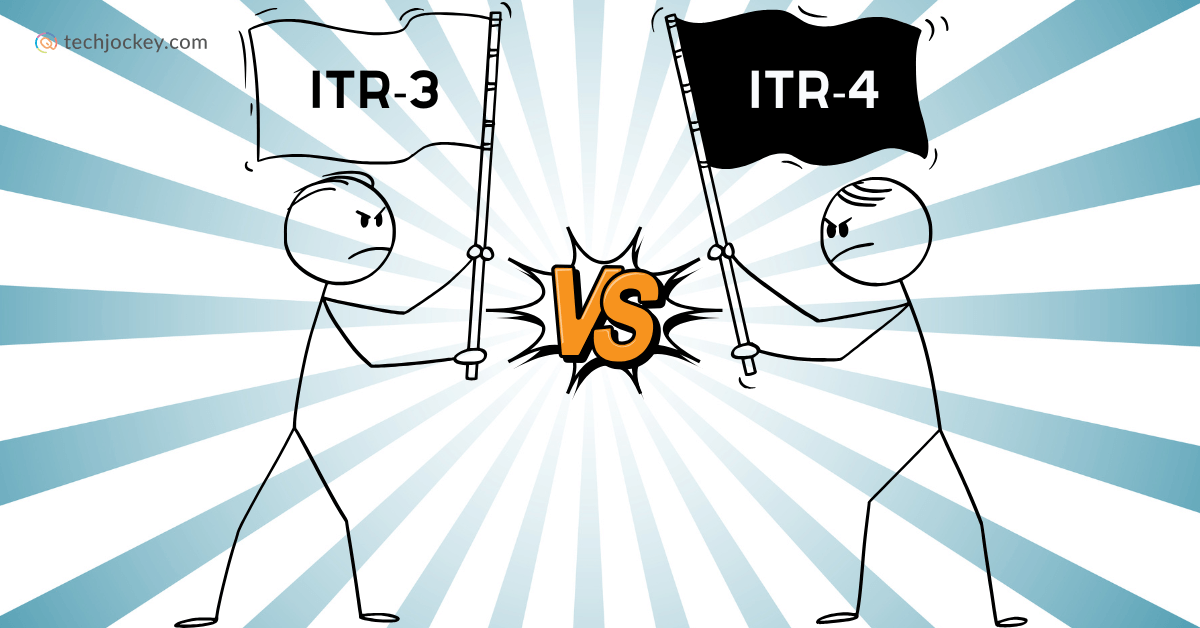
Every year, over 80 million Indian taxpayers file income tax returns and breathe a sigh of relief as they finally click ‘file’. However, a large number of those signing up still find it hard to differentiate between the sundry ITR forms, especially ITR-3 and ITR-4.
This gives rise to the infamous ITR-3 vs ITR-4 debate, one that needs answering as quickly and effectively as is humanely possible. This, so you don’t end up selecting wrong forms, wasting your precious time and risking tax notices.
So, let’s understand the key differences between the two forms and end the discussion once and for all, shall we?
ITR-3 is designed for individuals and Hindu Undivided Families (HUFs) earning from business, profession, or as a partner in a firm, provided they have not opted for the presumptive taxation scheme under Sections 44AD, 44ADA, or 44AE.
It covers a range of individuals, including freelancers, consultants, multi-property owners, company directors and more. All in all, if your income sources are diverse and your business turnover crosses INR 2 crore, ITR-3 is your form.
Suggested Read: How to File ITR-3: A Complete Guide
ITR-4, also called Sugam, is tailored for resident individuals, HUFs, or firms (excluding LLPs) who opt for the presumptive taxation scheme. Under Section 44AD, 44ADA, or 44AE, income and expenses are declared at prescribed percentages, simplifying calculation and record-keeping.
The catch with filing ITR-4, however, is that your total income must not exceed INR 50 lakh, and property ownership is limited to one house.
Suggested Read: How to File ITR-4: A Complete Guide
| Aspect | ITR-3 | ITR-4 |
|---|---|---|
| Type of Income | Salary, multiple house properties, capital gains, business/profession income, partnership income | Salary/pension (≤₹50L), single house property, business/profession under presumptive scheme |
| Eligible Taxpayers | Individuals & HUFs not under presumptive scheme, company directors, unlisted equity shareholders, requiring tax audit | Resident individuals, HUFs, partnership firms under presumptive scheme, small businesses/professionals |
| Accounting & Audit | Books of accounts mandatory above Section 44AA limits; tax audit if Section 44AB thresholds crossed | No books or audit required; income presumed under scheme |
| Deductions & Disclosures | Extensive deductions & allowances; detailed reporting of revenues, expenses, assets | Fixed deductions under presumptive scheme; less paperwork |
| Complexity | Detailed, multiple schedules, complex to file | Simple, fewer fields, easy to file |
| Business Size | Turnover >₹2 crore or professional receipts >₹75 lakh → mandatory | Smaller businesses/professionals within limits can opt |
Type of Income
Eligible Taxpayers
Accounting & Audit Requirements
ClearTax Income Tax
Starting Price
Price on Request
Deductions & Disclosures
Complexity
Business Size
If your business turnover exceeds INR 2 crore, or if your professional receipts go above INR 75 lakh, ITR-3 is compulsory. Contrarily, smaller businesses and professionals, as long as their numbers don’t breach prescribed limits, can opt for ITR-4 for ease.
You should file ITR-3 if…
You should file ITR-4 if…
Understanding the difference between ITR-3 and ITR-4 becomes much easier when we look at real-world examples. Below are some practical case studies that show how different taxpayers should choose between the two forms…
Conclusion
ITR-3 vs ITR-4 is not a simple choice, but one that affects your compliance risk and tax optimization. However, now that the difference between ITR-3 and 4 is clear to you (hopefully so), don’t shy away from taking charge of your taxes like a pro.
Pro tip: If you any doubt still, consult a tax professional or make use of an income tax software, for these can auto-select your best-fit form and make the process as easy as breathing.
With so much competition in the market, it’s important to make the right decision for… Read More
Artificial Intelligence is changing fast, almost faster than we can keep up. A few years… Read More
‘The global losses due to cybercrime are estimated to hit approximately 10.5 trillion USD per… Read More
With the advent of online shopping, or e-commerce as many term it, we are no… Read More
Today, artificial intelligence is everywhere. It powers apps, automates workflows, and even makes decisions for… Read More
Research says, ‘Retrieval-Augmented Generation (RAG) market is on track to grow from USD 1.2 billion… Read More